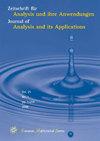Sobolev Embedding Theorem for Irregular Domains and Discontinuity of $p \to p^*(p,n)$
IF 0.7
3区 数学
Q2 MATHEMATICS
引用次数: 0
Abstract
There are a lot of results on the field of characterization of qΩ(p) for classes of domains. For a Lipschitz domain Ω the function p∗(p) = qΩ(p) is continuous and even smooth, (see (1.1)), this was proven by Sobolev in 1938 [12]. Later, the embedding was examined on some more problematic classes of domains by V. G. Maz’ya [9, 10], O. V. Besov and V. P. Il’in [3], T. Kilpelainen and J. Malý [5], D. A. Labutin [6, 7], B. V. Trushin [13, 14] and others. For further results and motivation we recommend the introduction by O. V. Besov [2]. Even considering somehow irregular domains, examined classes of domains have always qΩ(p) somehow nice and continuous. We construct a domain Ω such that the function of the optimal embedding qΩ(p) is continuous up to some point, has a leap at this point and then it is continuous again. The point of discontinuity p0 ∈ [n,∞) and the size of the leap can be chosen as desired. Our work is inspired by the construction of a domain in [4], but our proof is completely different. The original article shows the construction of such a domain不规则域的Sobolev嵌入定理及p \到p^*(p,n)$的不连续
关于qΩ(p)的表征领域有很多结果。对于Lipschitz域Ω,函数p∗(p) = qΩ(p)是连续且均匀光滑的(见(1.1)),这已由Sobolev于1938年证明[12]。随后,V. G. Maz 'ya [9,10], O. V. Besov和V. P. Il 'in [3], T. Kilpelainen和J. Malý [5], D. A. Labutin [6,7], B. V. Trushin[13, 14]等人在一些更有问题的域类上对嵌入进行了检验。为了获得进一步的结果和动机,我们推荐O. V. Besov[2]的介绍。即使考虑一些不规则的域,所检查的域类也总是qΩ(p)在某种程度上是好的和连续的。我们构造一个域Ω,使最优嵌入的函数qΩ(p)在某一点前连续,在这一点上有一个跳跃,然后再次连续。不连续点p0∈[n,∞)和跳跃的大小可以任意选择。我们的工作受到了[4]中构造域的启发,但我们的证明是完全不同的。原文展示了该域的构建过程
本文章由计算机程序翻译,如有差异,请以英文原文为准。
求助全文
约1分钟内获得全文
求助全文
来源期刊
CiteScore
1.80
自引率
0.00%
发文量
16
审稿时长
>12 weeks
期刊介绍:
The Journal of Analysis and its Applications aims at disseminating theoretical knowledge in the field of analysis and, at the same time, cultivating and extending its applications.
To this end, it publishes research articles on differential equations and variational problems, functional analysis and operator theory together with their theoretical foundations and their applications – within mathematics, physics and other disciplines of the exact sciences.

 求助内容:
求助内容: 应助结果提醒方式:
应助结果提醒方式:


